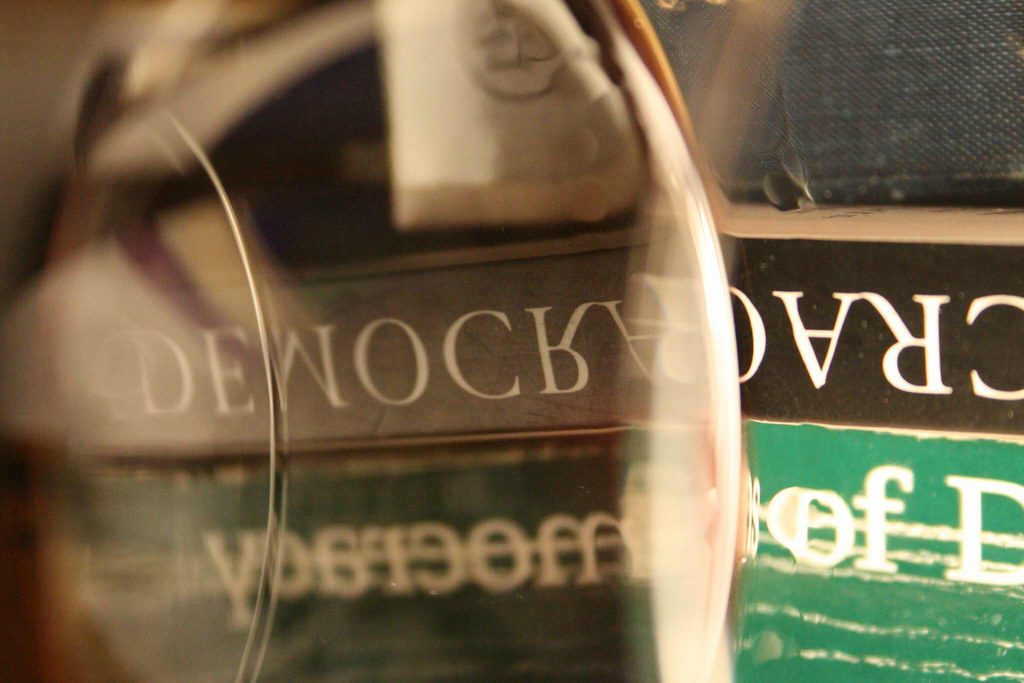Majority Rule, Plurality Rule, and Minority Rule
Definitions are fun, right?

Just to get this out of my system. (I feel like I have written something like this before, but I didn’t readily find the post, so here we go). There are some basic definitions to run through and then I want to differentiate between decision rules and the cumulative effects of collective decisions if the structures are flaws. A system can have discrete rules that appear fair but when summed together aren’t.
Frist, definitions:
Super-majority means needing more than 50%+1. This could be as little as requiring 50.1% to win instead of just 50%. Normally it is 60%, 67%, or 75%.
Absolute majority means 50%+1. In other words, no other outcome can get more. One notes the “+1” because it eliminates the possibility of a 50%-50% tie.
Simple majority (or plurality): the most, but less than 50%+1. For example, HRC won a plurality (the most) popular votes in 2016, but not an absolute majority.
Minority rule in this kind of conversation means having the second most votes (or less).
Given these definitions, we can talk about discrete events (an election or a decision) and talk about whether it requires super-majority, absolute majority, or simply majority thresholds.
For example, we expect congressional committees to function by majority rule. We expect the floors of both chambers of Congress to function by majority (or as is often the case in the Senate, super-majority) rule. We expect the Supreme Court the rule based on majority rule (hence the focus on 5-4 split decisions). In each of those cases, we are looking for at least an absolute majority to make the decision.
For most elections in the US, plurality rules win the day, although in a few cases (some state primaries, and for some general elections in LA and GA) an absolute majority is required.
In all of these examples we are seeing a decision-rule (passing a bill, rendering a court ruling, or electing a person to an office) and how it might be plurality, absolute, or super-majority.
There is also a broader context as to whether beyond a discrete decision is majority rule (simple or absolute) that the system itself is majority rule or not.
For example: every member of Senate is elected by either plurality or absolute majority. But is the Senate, as a whole, an example of majority rule?
No, it isn’t, because the distribution of seats in the chamber is not equitable relative to population. So, we are in a position wherein the majority of seats represent a minority of American citizens. The fact that it is designed to work that way doesn’t change the reality of what I just stated. And the fact that it is designed that way does not make it just.
Now, sometimes the majority of the popular can control the Senate, but this is frequently not the case.
The same maldistribution of power applies to the Electoral College, and for similar reasons.
And while it is true that the majority of electoral votes may also go to the majority of the country, increasingly we are seeing a disjuncture there.
It is further important to note that the House of Representatives can go to the party that loses the national popular vote (as happened most recently in 2012). (For more on that see my 2018 post, Rural v. Urban Representation and the Quality of Democracy).
So, in 2020 we are currently being governed by a President who came to office with minority support and we have Senate that is controlled by a minority of citizens. The House cannnot govern by itself, so what else can we call this than minority rule?
Beyond that, at the state level there is no guarantee of majority rule. A clear example is Wisconsin:

That is quite clearly minority rule, even if at the district level every representative was elected by plurality. See my post The Basic Democratic Problem in Wisconsin for more information.
Indeed, the Wisconsin state legislature substantially illustrates how what seems to be a democratic decision rule (plurality winners in single-seat districts) can still lead to a decidedly undemocratic outcome insofar as the legislature does not actually represent the statewide preferences.
The goal of a representative system should be, if one takes representation seriously, to represent the population in government. Rules and structures can either enhance that goal, or they can undercut them.
By the way, I would agree that unfettered, simplistic, and absolute majority rule (i.e., the ever-popular tyranny of the majority) is a problem. But that can be controlled by diffused power (federalism, separation of powers) and explicit constitutional protections (the Bill of Rights), and other legal protections.
But if we are concerned about majority tyranny, then surely minority rule, to include the ability to control the institution that can define basic rights (SCOTUS) is even more problematic, yes?
There is another word that can be used for minority rule, and it is authoritarianism. The entrenchment of minority rules means that consent of the governed has gone out the window, and while minority rule via constrained elections is better than a dictatorship, it still isn’t a democracy.
(And, to be honest, I not sure I really got all that much out of my system…).






I have an odd question, @Steven: you teach, how does your average freshman student compare to the OTB commentariat in terms of understanding the basics of politics and government?
Very useful to know (at least for those of us who follow politics casually). For instance, I didn’t realize plurality was the same with simple majority (I always thought majority always implied over 50%). I guess I’d say plurality is a better word choice for the most but less than 50%, as its clearer.
When it came to political violence, white made right.
Uppity folks got knocked down a peg or three.
Discussing political majorities in an American context also means discussing race.
@de stijl:
Historically, most political violence is between people of the same race, and it’s generally wealth that decides whether the violence was “justified” or not.
Violence between races (despite what conservatives say when trying to stoke up fear) is almost always a small fraction of the violence between members of the same race.
@de stijl: No one could doubt the importance of the racial issue and I’m not disagreeing with you exactly … BUT …
There is a significant part of the American left that would modify the race discussion by saying it is mingled and coexists with socio-economic class. With wealth, in short. And the political behavior of minorities of wealth gives a lot of validity in my ‘umble opinion (tugs forelock, backs away).
In counties and communities that were majority black a white minority ruled the roost for decades and decades after Reconstruction failed, or got bailed on.
Fear. Voter suppression. Militias. Police. Political violence. American apartheid.
@Northerner: I don’t think “simple majority” gets a lot of use outside of certain circles. Plurality seems much clearer.
@de stijl:
But didn’t they also use violence and oppression against poor whites? Shooting union strikers, letting the poor of any race die or starve without medical coverage, suppressing their votes (when did whites who weren’t property owners get the right to vote in every state?) Even now something like 500 white men are killed by the police every year — want to guess how many of those are rich?
Racism is a big part of America’s (and Canada’s) history, but so is discrimination against the poor (though Canada has done better than America in that regard lately thanks to public health and the social safety net). Lumping all whites together, as if they all get the same benefits, is another conservative trick, and is false. Poor and middle class whites have way more in common with poor and middle class of other races than they do with the rich.
@Northerner: We’re not supposed to say that part about poor whites and poor minorities having more in common out loud, or conservatism as a whole will crash and burn. It goes against everything capitalism has built in the last 100 years, if the peons find out they’re all just cannon fodder and worker bees, with no real opportunity to realize the American dream and “pull themselves up by their bootstraps”, it would be a real….Revolution.
@Michael Reynolds: An interesting question.
I have not taught undergrads for about four years, since I moved into the Dean role, but I would say, as a group, far better than most freshmen and perhaps not as well as most undergraduate PS majors.
@Steven L. Taylor:
That sounds about right to me. I wanted to take the temperature of the incoming kids. The ones I deal with are bright, often passionate and committed, don’t necessarily have much of a database in their heads. Very little history.
@Michael Reynolds: Given what they’re being taught in public school, it’s not surprising. Both my kids are pissed off that their virtual school has in depth social studies classes appropriate to their age range, and it’s the class they both struggle with. There’s less “history” being taught in Wyoming than I guessed. I remember having a badass social studies teacher every year from Freshman on, now history is an “elective” at the same school I went to.
@Jax: SHHHHHHH! [you’re not supposed to tell people this 🙁 ]
@Steven L. Taylor: Now I want ratings for all of us.
Does Kathy, not living in this country, have a better understanding of US politics and government than the average undergrad poli-sci major? I would not be surprised if the answer was yes.
@Jax: I would suggest that the separation of poor whites from poor minorities is, in large part, done by the poor white folk themselves, in order to have someone to be better than. And that self-delusion is then exploited by the Republicans.
The pedants among us always like to point out that since so few people vote no one actually wins a vote from the majority of Americans. So you have to play this game where you point out that what we are talking about most frequently is who got the most votes and who got less votes. So yes, maybe it is a problem that not enough people vote. Maybe it is a problem that when Clinton won he had a plurality and not a majority of those who voted. However, that doesnt mean it is OK if we keep having the country run by the party which keeps getting fewer votes. (And to throw in the usual caveat just because this is the way the system was designed doesnt mean it is not problematic. A voting system designed 200 plus years ago may not work so well when things change.)
Steve